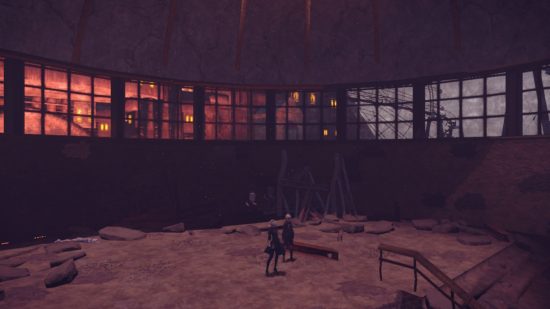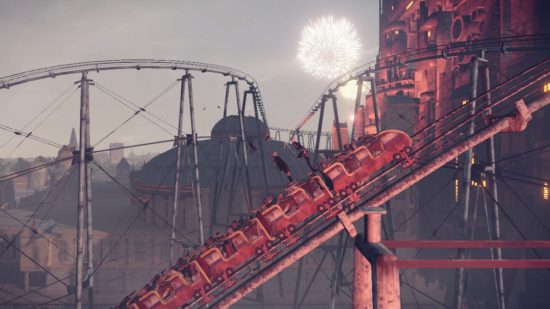Our Verdict
Nier Automata is one of the best games from the previous generations of consoles, and it has made the jump to the Nintendo Switch in a mind-bogglingly impressive fashion. Little to no noticeable compromises have been made to get it onto a handheld system, and the magical, inventive nature of the thing sings just as loud as ever.
It’s funny to play through Nier Automata’s introductory segment all these years later. It put a smile on my face, not in a plain, nostalgic way, but in a genuinely humoured way. It made me chuckle.
The introduction to Nier Automata is a confident showcase of most of the tricks it offers. The first genre is an Ikaruga-style shoot-’em-up, flying over dilapidated buildings and choppy seas. The first thing your fingers touch in-game is not its primary genre. This is hilarious and excellent.
It continues with a taste of Platinum’s combat chops later and then some side-scrolling action-platforming. It just keeps going, showing you the world through a variety of different lenses with a gleeful grin on its face. By the time you’ve finished one of its main endings (there are 26 in total), you probably also came across a text adventure segment. This game is wild.
However, the difference this time around is that I got to experience this raucous 45 minutes of genre-hopping horizontally. What I mean, is, I was lying down in bed, recovering from some nasty illness I’d caught at EGX, playing on my Nintendo Switch. I was delirious on medication, twirling around and slaying clown-faced machines. It was exquisite.
So, if you don’t already know, Nier Automata is one of the best action games of the last generation. Initially released in 2017, it tells the story of a war between androids and machines in the year 11945, after aliens force humans to flee from the earth. This backstory isn’t really why we’re here though.
We’re here for three things Nier Automata excels at: combat, philosophising, and wackiness. The latter covers everything from the wild genre jumps, engaging story beats, and a consistent sense of humour running through everything. Whether it’s a half-baked side quest or a main set piece moment, this game is bursting with ideas, all without being too po-faced to irritate.
When it comes to philosophising, you could consider Yoko Taro’s heady ideas a little po-faced, but I think the humorous references to Jean-Paul Sartre cut that down immediately. Sure, the story includes abstract reflections on war, death and consciousness, but it does it through the lens of grumpy androids that learn to have emotions and the loud screeches of ball-headed machines. It’s all a bit too silly to be overly earnest, right?
Then there’s the combat. This is classic Platinum; there’s a light attack and heavy attack which you can combine into different combos, there’s a dodge you can use to improve a combo when you time it just right, and there’s a floating device that can shoot a variety of projectiles, alongside a dustbin full of different augments to adjust the combat to your liking.
So, we’ve covered what I consider the three main pillars of Nier Automata. If you love one of these, you’re likely to enjoy the game. But diving in deep five years after release isn’t really valuable to any prospective buyer of the Switch version. If you want a deep dive, go read one of the many excellent reviews from the time of its release. Instead, with Nier Automata: The End of Yorha Edition, the key questions are technological.
So, given the Nintendo Switch’s graphical constraints, how is the port? Well, it’s basically perfect. For a grand open-world game with red-hot action to translate easily to a handheld device is mind-boggling. Every inch of the action is as red-hot as ever.
As you run through vast deserts or in between vine-consumed buildings, there’s barely a hint of pop-in. Textures are detailed enough in both handheld and docked that I struggle to notice any differences between this and the original release, at least in terms of graphical fidelity.
One place it seems to make concessions, however, is the handheld resolution, but not to any extent that it becomes a hindrance. If you look really closely, things are slightly blurrier than is comfortable, at least on the big OLED model’s bright screen. In spite of this (or maybe because of my illness), I played most of the game out of the dock.
When I put it into the dock, the resolution is much crisper. I feel like I notice slight framerate drops or stutters when docked, but these are such fleeting moments that I can’t be 100% sure they actually happen. You have to really be looking to find any points that this port starts to suffer.
Another place you could take a magnifying glass to is the input lag, which to my fingers, definitely feels a little flabbier than when I first played the game. But still, I’m not writing for Digital Foundry. I do not have the means to properly test the minutiae. It could just be the hyper-medicated delusions of some throat-infected idiot.
Still, I highlight these tiny roughnesses to emphasise their tiny state. Through my first ten hours with the game I barely saw a hitch, and even when I did, I couldn’t be sure that it was actually present because it was such a micro-second occurrence. This is one of the best Switch ports I’ve ever seen.
So, the port is good visually, but how about aurally? Well, voices don’t sound over-compressed – a common issue with big, fully voice-acted games that make the leap to Switch – and the music of Keiichi Okabe is as brilliantly grand as ever. Game sounds good. Nice.
Here then, we have a lightning-quick action game full of genre-defying ideas and genuine playfulness ported to a portable console in exquisite fashion. The question is, why should you play it here? Well, I can’t really answer that. If you’re yet to experience it, the Nintendo Switch is an excellent place to do so. If you have played it but want to tackle it again on the bus, do it! Either way, it’s up to you. But, in an attempt to convince you, let me tell you a story.
I went to EGX – a videogame convention in London – the weekend before this review. I had a nice time. Videogames are pretty fun. I got a little unwell on the Monday after. I had a sore throat. By Tuesday, I was very unwell. I used sick days, went to the doctor, and got given a bucket of penicillin to deal with a throat infection I am still suffering from.
I lay in bed. I got the email with my Nier Automata code within. I downloaded the game. After the wild ride of the introductory segment, I just kept going. This game kept me awake. Then, after around four hours, I got to the amusement park segment. I rode a rollercoaster with 9S, fought some mechanical enemies on the way, and then encountered Simone the Songstress’ boss fight.
This boss fight is still one of the best things I’ve experienced in an action game. Beyond Automata’s heady philosophising, thrilling genre-hopping, and general playfulness that is so endearing, the game is fundamentally good. Even without all its wild ideas, on a plain, mechanical level, it has some of the best stuff out there. And it thrilled me all the same, lying in bed, filled to the brim with medication, staring at a bright OLED screen in a pitch-black room.
In summary, Nier Automata: The End of Yorha Edition is one of the most impressive Nintendo Switch ports to date, so impressive that it kept me from sleeping at night while seriously unwell. If you know nothing about this game and want something new for your portable console, it’s an easy recommendation. Alternatively, if you’re itching to dive back into that world, here’s a great place to do so. It’s just endlessly impressive.









